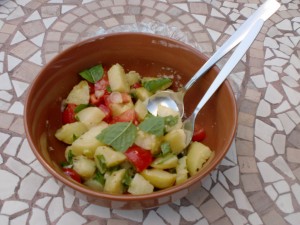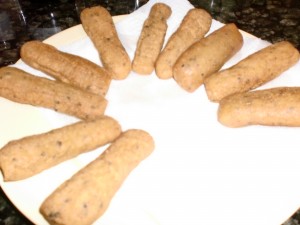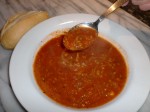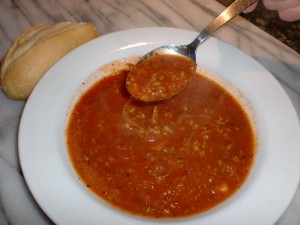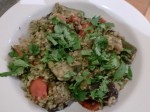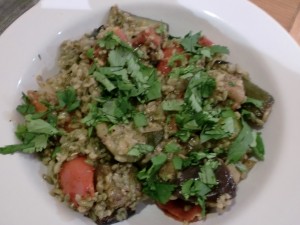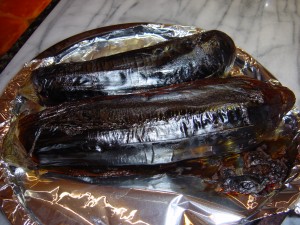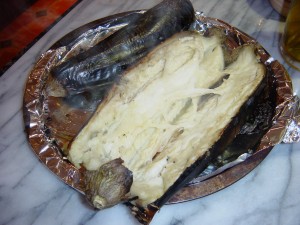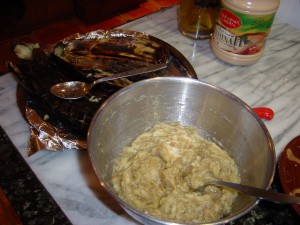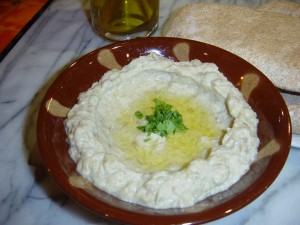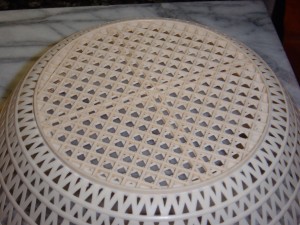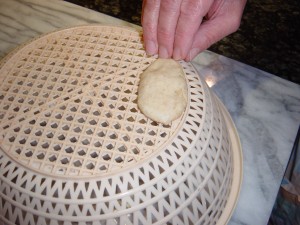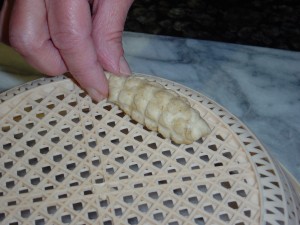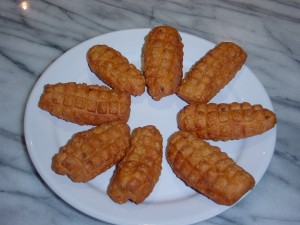Ardi Choki literally translates the thorn (choki / chawki) from the ground (ard), indicating that this plant belongs to the thistle family. Its initial growth is marked by a pretty purple flower head, while the thorny tips of the leaves is another noticeable thistle characteristic. You will find a good illustration of the Globe Artichoke .
It is worth mentioning that there are three types of artichoke plants which are unrelated: Globe Artichoke, Jerusalem Artichoke and Chinese Artichoke, however, my main focus here is the culinary usage of the Globe Artichoke in our cuisine. The two recipes below demonstrate our simplistic way of cooking artichoke as an appetiser or as a starter.
Artichoke benefits
According to the articles I read, globe artichoke leaves are valued together with the rest of the plant for their health benefits. Apart from their high fibre content and antioxidants, globe artichokes are praised for their properties in:
Cancer prevention
Increasing bile flow
Liver health
Treatment of hangover
Helping digestion
Reducing cholesterol
See also this article on the health benefits of Globe Artichokes.
When buying globe artichoke:
Make sure it is firm with tight fresh green leaves and feels heavy when you hold it.
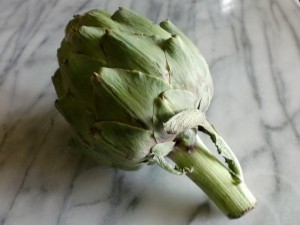
A raw Globe Artichoke
How to prepare and cook a whole globe artichoke
- Place the artichoke on a strong cutting board, remove the toughest outer leaves at the base. Grip the stem and cut off most of it leaving only about 3cm on the artichoke.
- Trim the stem with a paring knife, removing any tough fibres surrounding the base. Some cooks prefer to trim off the thorny bit of the top of each leaf, I don’t.
- Now rinse the artichoke under a cold water tap.
- Next, fill a pan large enough to fit all the artichokes comfortably so they are covered with water, to which you add salt and lemon juice, some cooks prefer to cut a lemon into wedges and throw it in.
- Bring to the boil then drop in the prepared artichoke, making sure it is well submerged and let it boil gently uncovered for about half an hour to 40 minutes (depending on the size), or until you can easily pull away an outer leaf.
- Once it is cooked, place the artichoke upside down in a colander and drain well.
Globe Artichoke Leaves with Lemon Dressing
Ardi Shawki maa Salsit Hamoud.
This is a very simple and basic recipe that you could use as a tasty appetiser, which is very low in calories. Artichoke can be served warm, at room temperature or even cold as some people prefer. When you eat a whole globe artichoke, watch out for the inedible part called the hairy choke: simply scoop it out and discard.
Serves 4
Ingredients.
- 4 globe artichokes: allow 1 artichoke per person
- 1tbsp lemon juice
- About 1 tsp salt
For the lemon sauce
- 1 fat clove of garlic peeled
- 4 tbsp lemon juice
- 7 tbsp extra virgin olive oil
- Salt to taste & freshly milled black pepper
Method
- Prepare and cook the artichokes as described above.
- Smash the garlic to a paste then simply whisk in the remaining ingredients. Taste and adjust if necessary then pour the sauce into two small bowls.
- Place the artichokes on individual serving plates along with the sauce bowls and serve.
- Take one leaf, dip it into the sauce and eat the tip of it then discard. When you reach the hairy choke that covers the heart or fond, simply remove it with a spoon and discard, then dip the whole heart into the remainder of the sauce and enjoy: it is delicious!
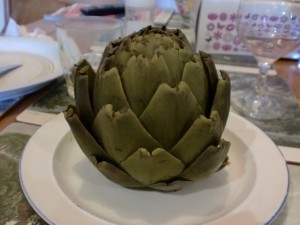
The Globe Artichoke cooked and ready to serve.
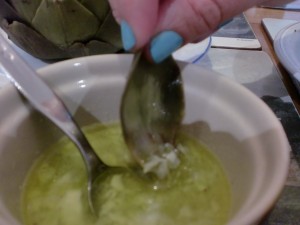
Dip the Artichoke leaf in the sauce then eat the tender part, discarding the tough outer part.
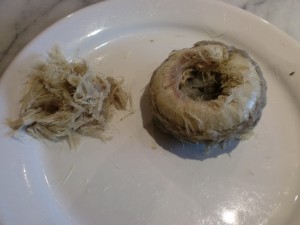
The Hairy Choke still covering the Heart
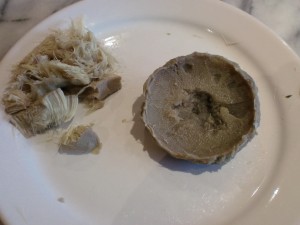
The Globe Artichoke heart after removing the Hairy Choke
Globe Artichoke & Mushroom Salad/ Salatit Ardi Chawki maa al Fitr
For this recipe, you need artichoke hearts which you can buy tinned, or prepare yourself, nevertheless, you can never beat the flavour of freshly prepared artichoke hearts.
I am not intending to explain how to prepare these artichoke hearts from scratch because there are good video clip demonstrations on the internet like on the following ones:
http://www.bbc.co.uk/food/techniques/preparing_artichokes
As for the mushrooms, I usually go for the chestnut ones because I like their nutty flavour.
Serves 4
Ingredients
4 artichoke hearts
120 g/ 4½ oz chestnut mushrooms, cleaned
1 small onion preferably red
3 tbsp of fresh chopped parsley
As a garnish base: A handful of mixed baby salad leaves such as spinach, beetroot leaves… washed and dried
25g pine nuts toasted (optional)
Dressing
2 fat cloves of garlic peeled
4 tbsp lemon juice
6 tbsp extra virgin olive oil
2 tsp sumac (optional)
Salt to taste & freshly milled black pepper
Method
- First cook the mushrooms. Drop the prepared mushrooms into a small pan of simmering water, add a pinch of salt and simmer for 5 minutes. Next, drain the mushrooms and leave in the colander until they are easy to handle then quarter each one and transfer into the salad bowl.
- To cook the raw artichoke hearts. Drop the prepared artichoke hearts into a pan of simmering water to which you add salt and 1 tbsp lemon juice, making sure that they are well submerged, top up with more boiling water if necessary. Simmer the for about seven minutes by which time the artichoke hearts should be tender, then tip into a colander to drain. Slice them into chunks then add to the mushrooms
- If using tinned artichoke hearts, simply drain them from the brine, cut into chunks and proceed as above.
- Thinly slice the onion then tip into the salad bowl along with the chopped parsley.
- Whisk all the dressing ingredients, season to taste then tip it over the salad and mix thoroughly. Taste and adjust if needed.
- Divide the baby leaves salad between the individual salad plates, top with the dressed salad and scatter the toasted pine nuts over (if you choose to do so). Serve at once.
- Toasting pine nuts: wipe a small frying pan with a little oil or butter, tip in the pine nuts and put on a low heat and let the nuts toast keeping a close eye and shaking the pan from time to time until they turn golden. Remove from the heat, transfer onto a small plate, they are ready for use.
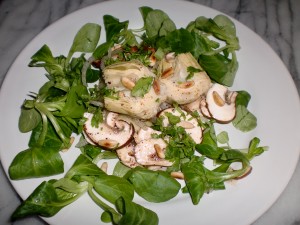
Artichoke and Mushtoom Salad

